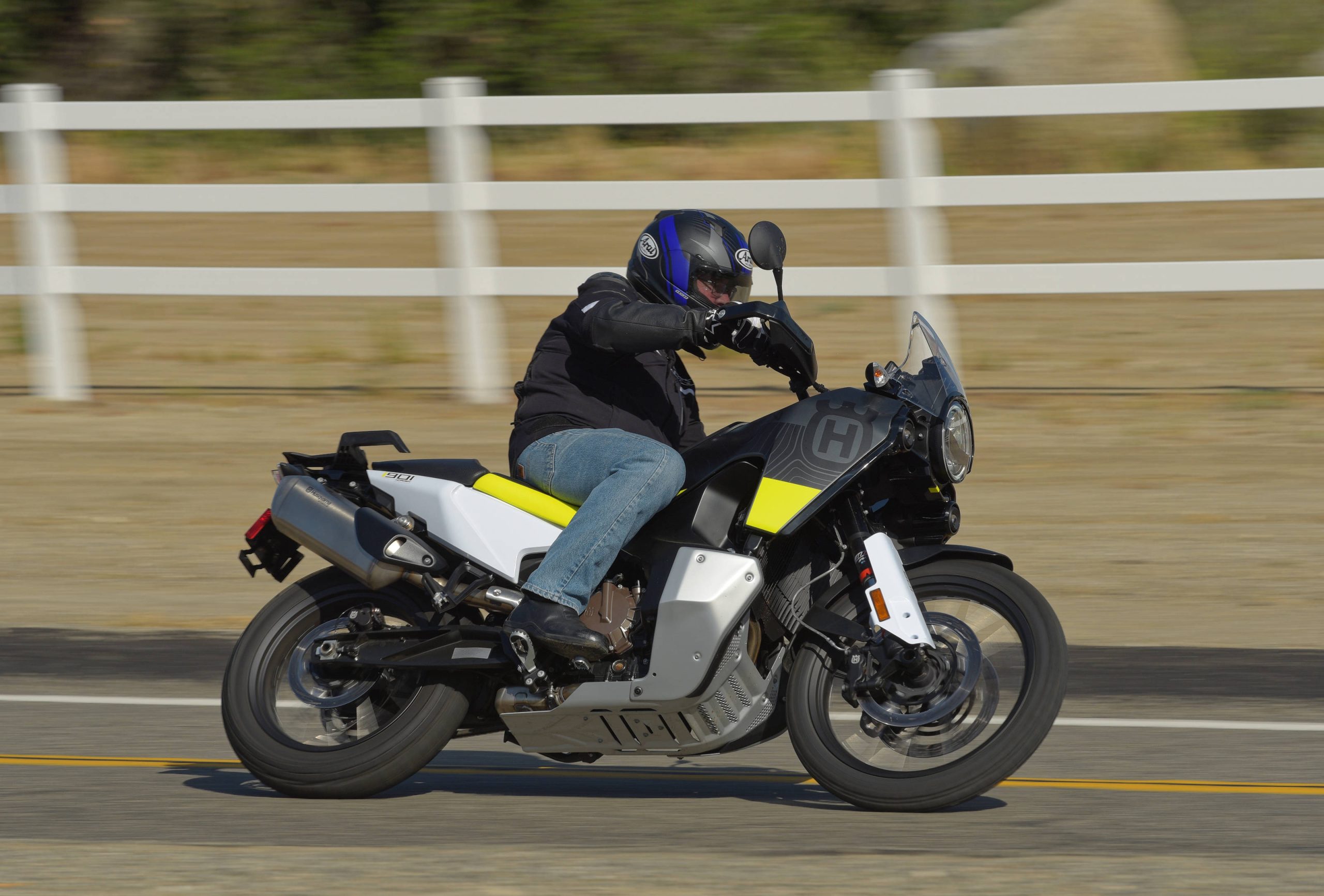
It’s no secret that MD is a fan of KTM’s mid-displacement adventure bikes. As editor, I personally own a KTM 790, and love the performance of the new 890 versions. Competition is coming, as it always does, for a popular category of machine.
Yamaha’s Tenere 700 is already here, of course, along with the Aprilia Tuareg 660, and others. A 755cc Honda Transalp and a new Suzuki parallel twin adventure bike are just around the corner. So competition will get stiffer, but KTM undoubtedly has plans to stay ahead.
Since the Norden 901 is based on the KTM 790/890 platform, you may want to take a look at some of our earlier 790 reviews and 890 reviews. The Norden gets the same 889cc parallel-twin engine found in the KTM 890 adventure models. There are differences, however.
The Norden fork is adjustable for compression and rebound like the 890 Adventure R, but features 43mm tubes vs. 48mm on the KTM. The shock on the Norden is adjustable for rebound and spring preload only, not for compression. Travel is 8.7″ in front and 8.5″ in the back, and the suspension is clearly softer overall than the more dirt-focused KTM.
The wheels remain 21″ front and 18″ rear, spoked, tubeless designs, but are shod with a more street-biased tire in the form of Pirelli Scorpion Rally STR. Brakes are dual 320mm discs in front squeezed by a radially-mounted four-piston caliper with a 260mm disc in back utilizing a two-piston caliper.
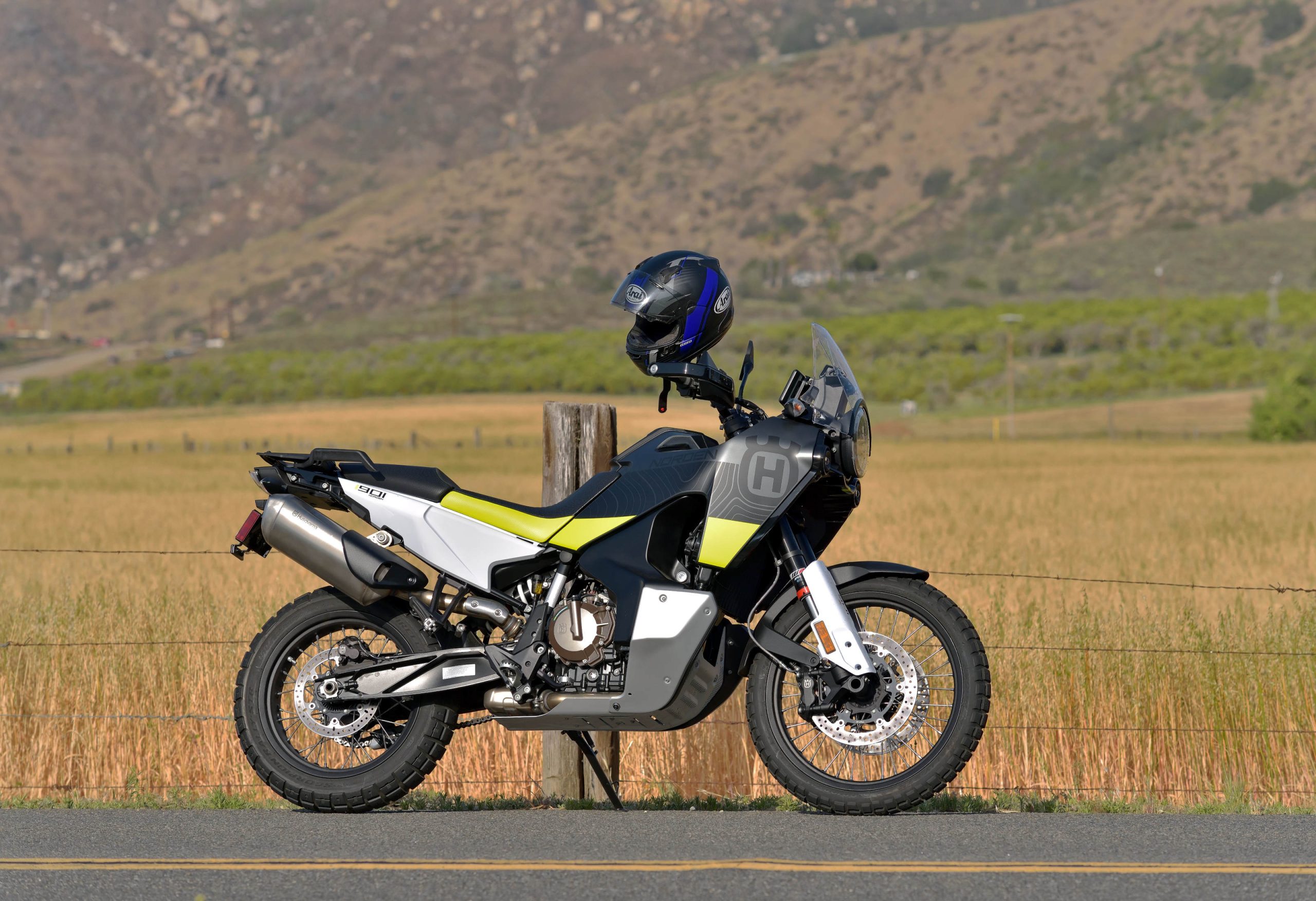
Styling is unique to the new Norden 901, as is the superb rider’s seat. A very interesting change from the KTM models is the size and shape of the fuel tank, which has not been emphasized by other reviewers.
A trademark feature of the KTM 790/890 adventure models is the low slung fuel tank, carrying a sizable portion of the 5.3 gallon capacity below the rider’s knees. This is a great benefit off-road, but a road bike generally needs a higher center of gravity to optimize handling. The Husqvarna fuel tank is an interesting compromise.
The Husqvarna Norden 901’s fuel tank is slightly smaller at 5 gallons, it carries less fuel down low and more fuel up top. This contributed to, in our opinion, a better centralization of the mass on the Norden 901 and superior on-road handling (more about that later).
The 5″ TFT instrument panel offers excellent brightness and contrast and a different scheme for informing the rider of the various settings. There is some use of images of the motorcycle and adjustments taking place as you make them. Although different from KTM’s approach, it is just as easy to follow and navigate.
Although you can see a pretty deep dive into all of the Norden 901 features and specifications in our preview article, here are some of the highlights before we get into our review of the ride.
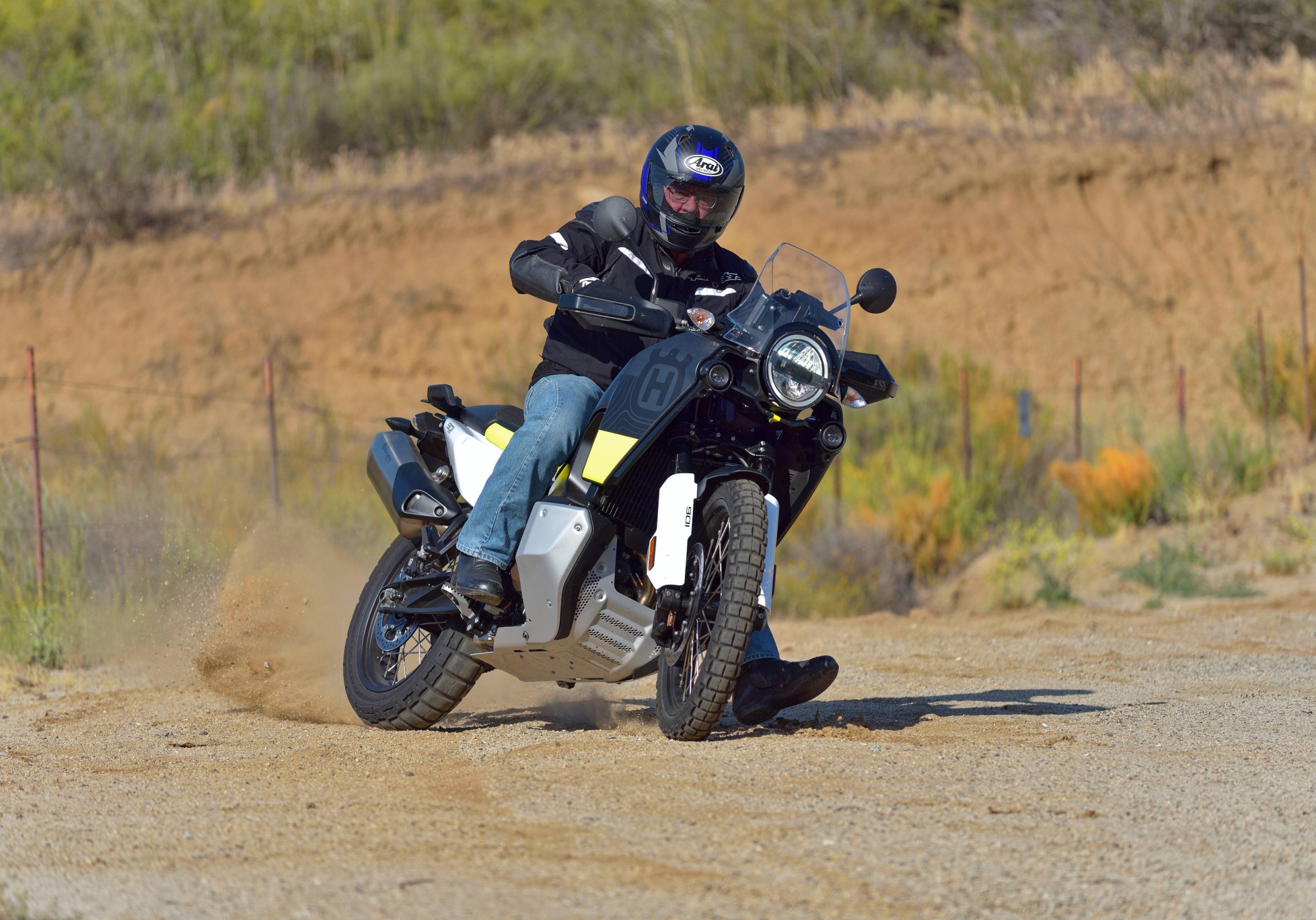
The Norden comes standard with three ride modes, including Street, Rain and Off-Road. Each of these has unique throttle response and traction control levels. Rain mode has reduced peak power, as well. You can purchase a fourth ride mode called Explorer, which offers more direct control over other electronic features. As an example, you can dial in exactly the amount of traction control you want. The Explorer mode itself offers quite direct, immediate throttle response, even when compared to the Street mode.
Standard features include cruise control, a quick shift function and ride-by-wire throttle. An integrated IMU allows incorporation of cornering sensitive traction control and ABS. Finally, the Norden 901 has a feature called power assist slipper clutch, which aids traction both on acceleration and deceleration.
The 43 mm Apex fork has separate adjustments on top of the left fork leg and right fork leg for compression and rebound damping. The shock, meanwhile, is adjustable for spring pre-load and rebound damping. These suspension components offer a great deal of convenience with the thumb operated compression and rebound adjustments on top of the fork legs, as well as the hand knob that allows you to easily adjust rear shock spring pre-load without tools.
Ergonomics are adjustable with six handlebar-mount positions and both a high and low rider seat position. The seat for the rider, as we said earlier, bears no resemblance to any of the KTM 790 or 890 adventure models. It is unique, and extremely comfortable, even over longer rides. It is narrow towards the front, assisting shorter riders in reaching the ground with both feet.
All of the lights on the Norden 901 are LED, including the standard pair of fog lights that sit on either side of the headlight. Although the 21 inch front and 18 inch rear wheels appear similar to those on the KTM models, the Norden features a higher end tire specification in the form of Pirelli Scorpion Rally STR tires, which we found to offer excellent grip, particularly on the road.
The front and rear brakes, as stated earlier, feature an ABS system informed by an IMU.
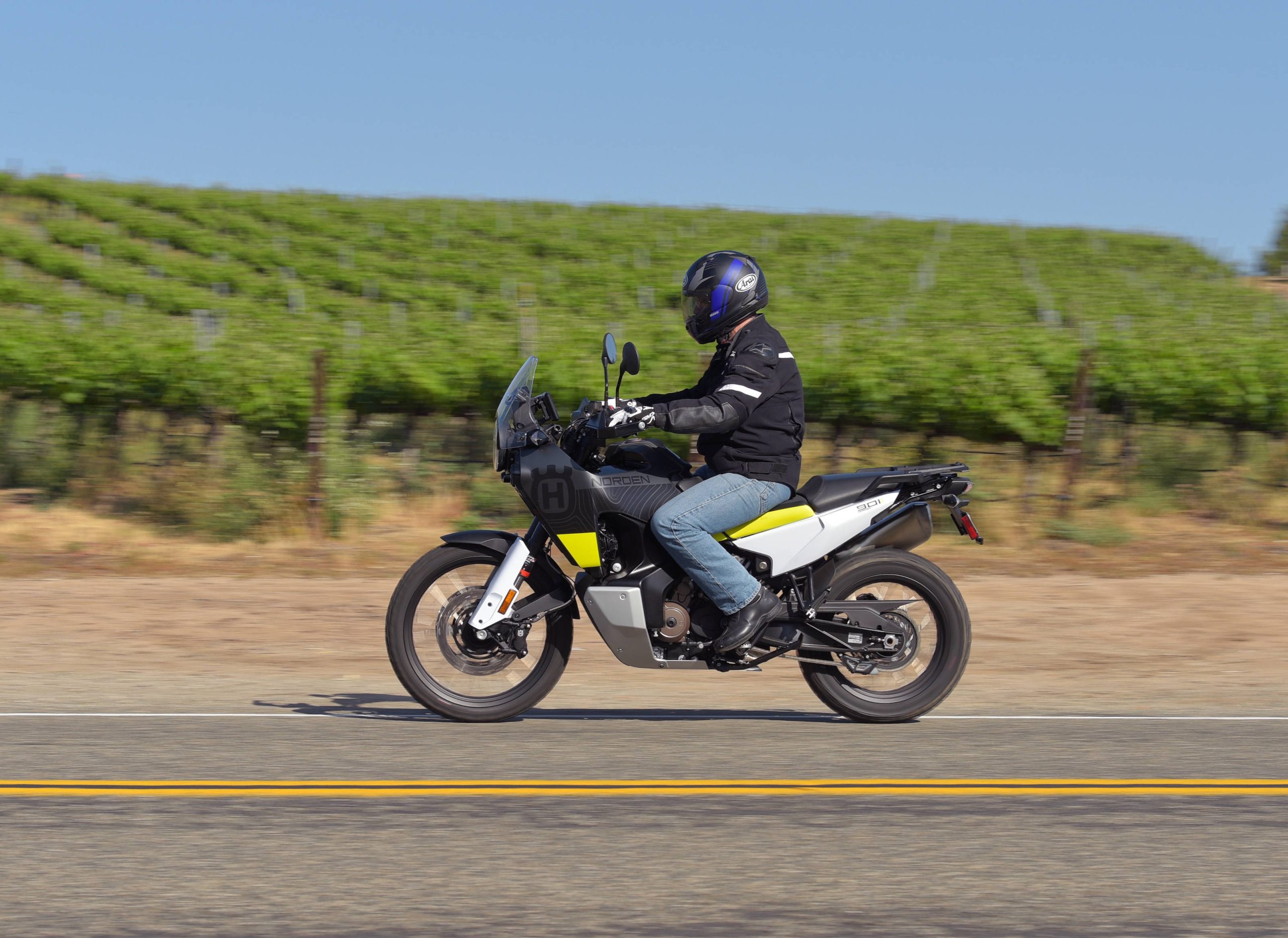
The 889 cc parallel-twin is a fantastic motor, in our opinion. If anything, it’s performance in the new Norden 901 seemed a little bit sharper, particularly in Explorer mode (comparing it with Rally mode on the KTM models). Fuel injection tuning seems quite good, with very little surge when opening a closed throttle in the more aggressive riding mode.
The six-speed transmission features slightly shorter shift lever travel and, as previously noted, comes standard with the quick shift feature that allows clutchless up shifts and down shifts.
Not surprisingly, riding the Norden reminds one of the KTM 890. This is one of the top engines in motorcycling. Good low-end power, a strong mid-range, and decent pull on top. The engine offers both flexibility and excitement.
The sharpest throttle response is in the optional Explorer mode (what KTM calls Rally). It is still very usable on the street, and we found the fuel-injection tuning by Husqvarna in this mode superior to that found on the last KTM 890 we rode in Rally mode. In other words, we were happy to keep the bike in Explorer mode, without being annoyed by any overly sharp, abrupt throttle responses.
The other major difference is the suspension. Travel is roughly halfway between the standard KTM 890 S model and the 890 R. The biggest difference, however, is the tuning of the suspension. The adjustable fork is excellent on the Norden. On the street, in particular, you can find settings for cruising on the highway or attacking a twisty road, and both work well. Small, stutter bumps are absorbed much better, in our opinion, than they are on the KTM 890 R we tested.
The shock performed pretty well, but it falls short of the excellent damping we found in the fork. The shock spring was undoubtedly too soft for our 200 pound test rider, but we didn’t have much of a problem with the fork springs, which seemingly could be dealt with by changing damping settings.
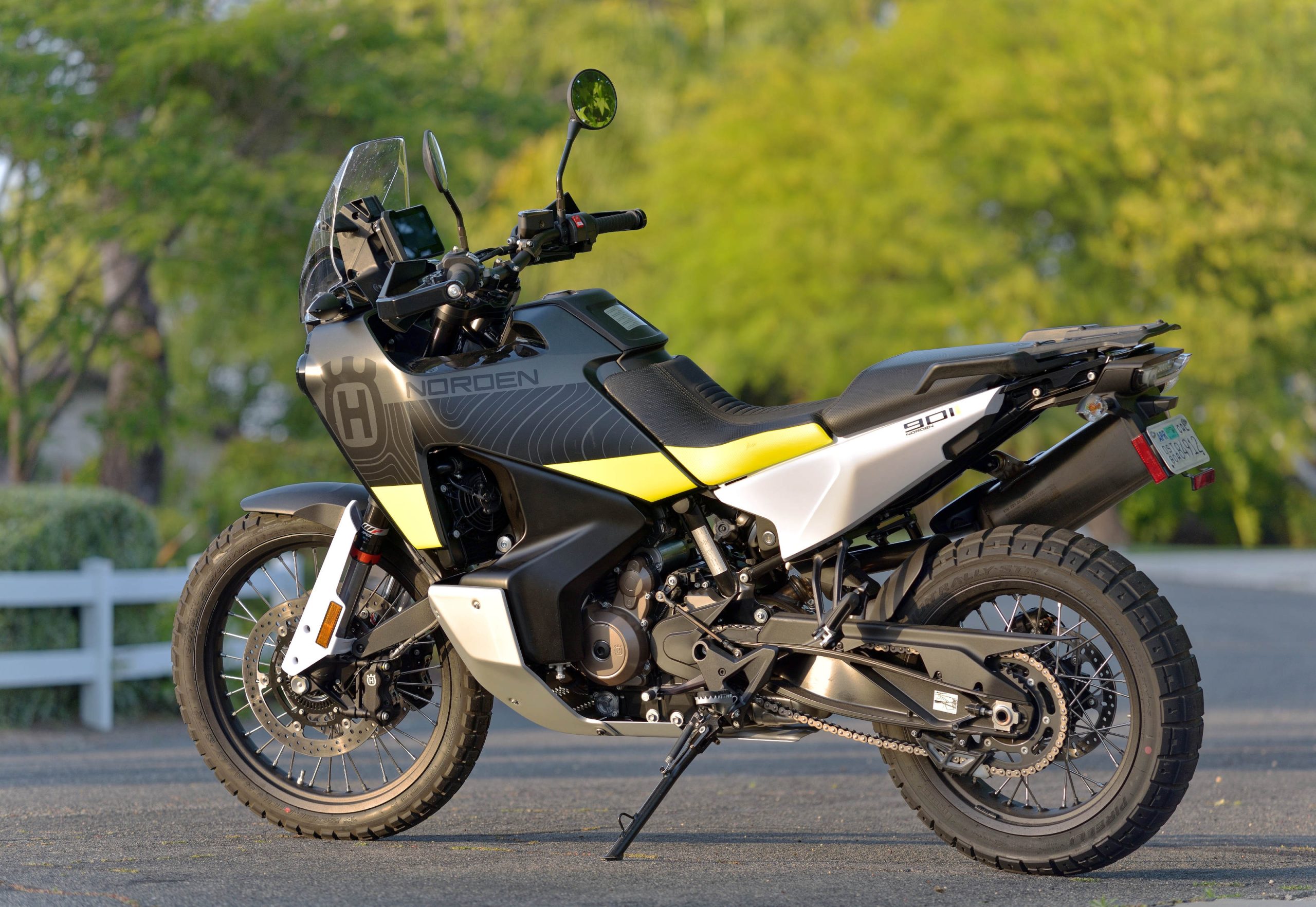
It seems that everyone who has tested the Norden raves about the comfort offered by the riders’ seat, and we will have to echo those praises. It offers that elusive compromise between support and comfort, and after several rides of 100 miles, or more, I don’t recall ever thinking much about the seat. It does its job, it doesn’t bother or annoy the rider on longer rides. We can’t ask for more.
One negative we noted following countless miles on the KTM adventure models was the width of the Norden gas tank between the riders knees. It is much wider than the KTM gas tanks. Nevertheless, after riding the Norden for a few weeks, we stopped noticing this. It is more noticeable when standing while off-road, but it disappeared from our minds on the street.
Speaking of riding on the street, here the Norden blew us away. The suspension settings, and the balance of the bike (after we added significant preload to the rear shock) provided surprising grip and confidence on the street. Plenty of credit goes to the stock Pirelli tires. The Pirelli tires offer good grip and excellent road feedback. They are somewhat less effective in the dirt, although they are justly labeled an 80/20 tire that still has some off-road capability.
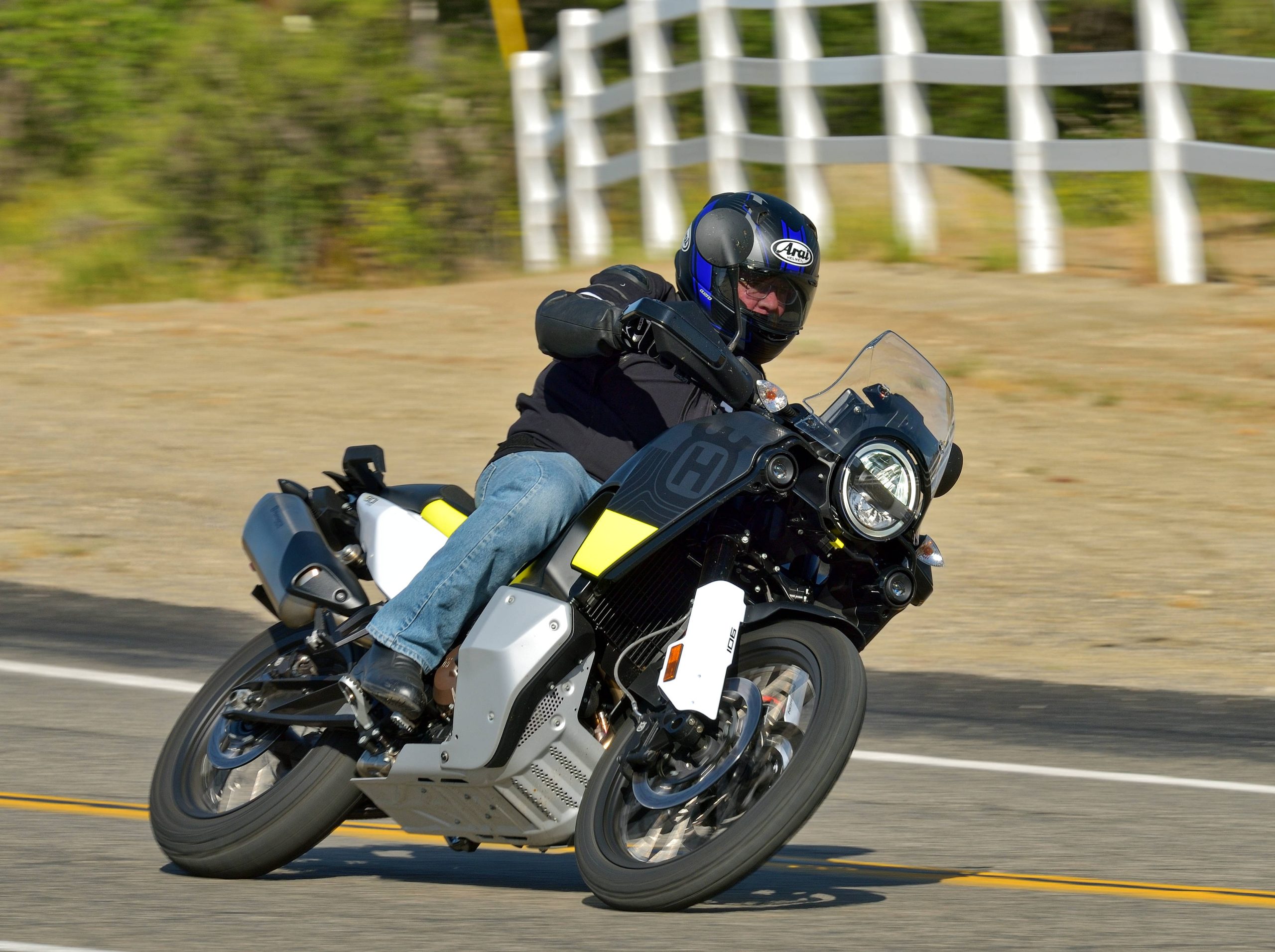
In the dirt, the Norden is a capable machine, but not designed for aggressively attacking the kind of terrain that a KTM 890 Adventure R is capable of. Generally, however, the owners of a mid-displacement Adventure bike do not hammer them off-road, but merely desire the ability to go off-road and deal with terrain that most bikes are incapable of handling. The Norden certainly fills the bill here, and the relatively small percentage of riders who want something like an 890 Adventure R can look elsewhere.
The Norden transmission shifts well and the quick-shift feature, although not the smoothest we have experienced, does its job. The brakes are strong and have decent feel.
Good wind protection contributes to an overall comfortable ride. This bike is more than capable of touring, and the 5-gallon tank offers good range (200 miles plus).
In the end, we fell in love with the Husqvarna Norden 901. Its versatility means you can use it for commuting, canyon scratching and off-road exploring in addition to touring. Few bikes are capable of all these disciplines, while the Norden 901 accomplishes each of them confidently. One more thing … the bike is an absolute blast to ride.
For more details, visit Husqvarna’s web site.






Nice bike. I called the dealer up one day inquiring about availability. He was like I’ll put you on the list, number 107 or whatever. Unobtanium. Makes for a nice story though.
Might be a great bike, I just wish they would make it uglier!
You’re correct Todd- the Norden does have a very 9X0 profile. Which is a huge plus imo. More important, the Norden is a better bike. I base that on owning a 950S (~25,000 miles) and a 990 Dakar (~ 30,000 miles) when they were current, and having the use of a Norden for a week (~500 miles). A lot of the being better is because of the electronics. I realize that’s a negative to some folks (usually those without much experience with modern electronics); but it also handles crisper on the street, can hold its own off pavement at a pace most owners won’t be able to do, has better brakes, better wind management, and is more comfortable.
Don’t get me wrong- the 9X0s are a riding experience not to be missed- they are unique and fantastic machines- but time marches on. Kind of the same with the 950SE (I put ~45,000 miles on mine) and the 7/890 being better hard core off pavement street bikes.
Kings die, long live new kings!
BTW- as much as I liked the Norden (which was a lot), I decided that there wasn’t enough weight difference between it an my 1190 Adventure (currently ~59,000 miles) to “downsize”.
I also would like to get my hands on a Norden but, if it is anything like the 9X0 Adventure bikes, I would still prefer a 690. The 950S I have tested didn’t accelerate any faster than a 690 and I imagine on and off road riding would just be plain better on something like the 690 Enduro/701. The 120+ additional weight of the Norden would do it no favors in any sort of aggressive riding. I do understand that not all riding is done to the extreme; I still enjoy riding my K75S even though it is around 190 pounds heavier than my Duke. As for an 1190, I swapped bikes with someone last week for a short ride. It was OK but I didn’t care for the excessive mass and how it gets in the way of handling and performance.
I get a kick at how a ride by wire throttle is described as a “feature”. Ride modes and cruise control are “features” brought to you by ride by wire. But ride by wire itself is something that I am supposed to want? What?
I might be an old grouch. But I get full cringe from the very idea of ride by wire on a motorcycle. I don’t like it in cars either. But a car is a big box that I don’t have to actively keep from falling over. I can feel the lag in these systems and it infuriates me. If I need to widen my line a bit and I gas it I want exactly what I ask for and I want it right NOW. This is my personal safety you’re messing with here.
I would like to thank everything that is holy for the used bike market. The new bike market has left the building.
The throttle action/response in my RBW 690 Duke is much better than the throttle response in my XR650L and certainly my old R75/5. Grab a handfull of throttle on the KTM and there is immediate, seamless, lag-free response. Do the same sort of ham fisted pull on the other bikes cable throttles and the bikes nearly flame out and bog. I don’t know which bikes you are referring to with your complaint but you probably shouldn’t judge all bikes performance based on an assumption or a generalization.
Have you done “Dave’s Mod” on your XR650L? it made a big difference on mine.
You’re supposed to get a hamfisted response, to hamfisted throttle operation. Neither the XR, nor old BMWs, assuming they were properly adjusted, had bad throttle response once in the sweet part of their powerband. Of course jerking the throttle open at idle on a big single, would result in suboptimal velocity and a boggy feel. But that’s because you’re attempting to feed a barely breathing engine with a windtunnel.
Remove that feedback, and you no longer control the throttle on your bike. Instead, you just request torque from some computerised throttle operator somewhere in Austria. Kind of like replacing the handlebar with some sensor which allows you to just point were you want to go, to prevent you from suffering any discomfort even if you should jerk the bars innapropriately.
The 690 is THE poster child for RBW, though. Hypertuned, no-flyweel singles were always some of the hardest and most frustrating engines to directly operate the throttle on. Hence had more to gain than anything else, by leaving that part of riding the bike to an Austrian expert hiding in the ICU. KTMs big twins, OTOH, are just pointlessly novocained to the point of being boring (I had two of them…..). Easy to ride waaay fast, boring to ride any other way. Not sure about the midweight twins.
Your L has a CV carb. Those are awful. I had forgotten about those until you sort of mentioned them.
The dark ages.
“I can feel the lag in these systems and it infuriates me”
Better tell the racers of the Paris Dakar, not to mention MotoGP & WSB, what they’re missing in terms of throttle connection.
Your comment is 30 years out-of-date.
I have a negative opinion of ride by wire. So does Enduro, Observed Trials, Dirt Track, Motocross…
I wouldn’t be too sure that all the Dakar bikes have it either.
In any case. It’s just my opinion. You don’t have to adopt it. I certainly won’t change it because you don’t seem to agree.
I’ve ridden and owned a number of recent KTM midsized and large twins. The throttle response on each one of them has been awesome, in my opinion. I usually find a single mode (often sport, on the street) which provides what I feel is the most direct response, without being overly sensitive, and leave it there. But I venture into street and rain modes when it gets cold and/or slick. I’ve been extremely impressed with the fueling on each bike and in each mode. Much better than any carbureted bike I’ve owned, and much better than the two injected Interceptors and two RC51s I’ve owned back in the day. I guess it’s a matter of preference but the recently developed injected KTMs have great fueling in my experience.
Well, it certainly is interesting looking. I think I would just pick up a 950 or 990 Adventure, it seems identical.